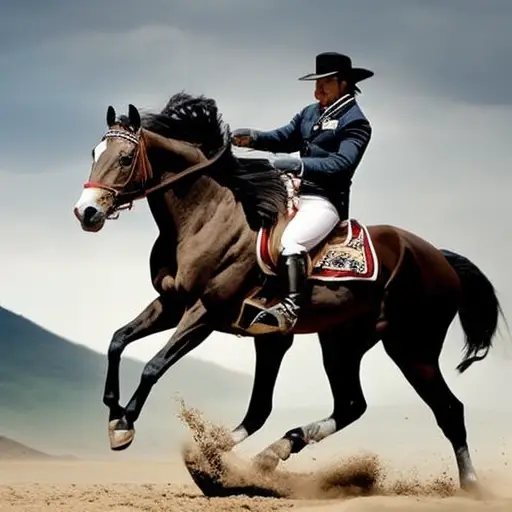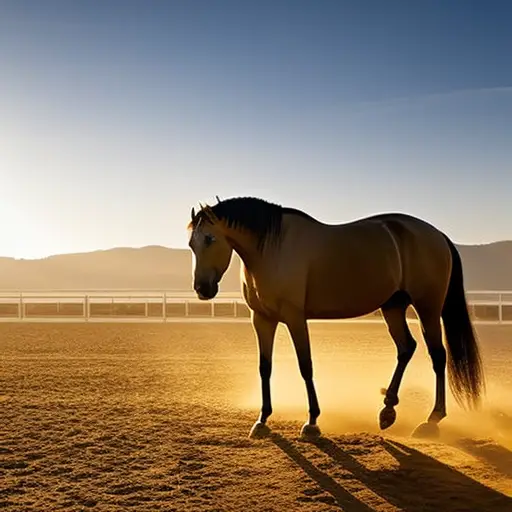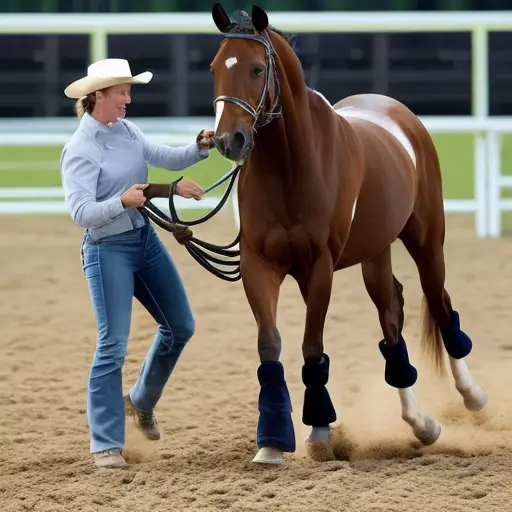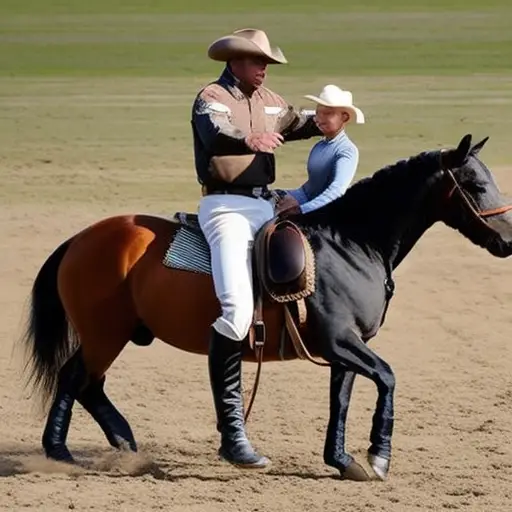Effective Communication: Understanding Horse Body Language

Imagine you’re in a conversation with a horse. But instead of words, the horse communicates with its body. Every flick of an ear, every swish of a tail tells you something. Understanding horse body language is like learning a new language, one that reveals their thoughts, feelings, and intentions.
In this article, we delve into the intricacies of effective communication with horses, decoding their facial expressions, body postures, tail movements, and more. Get ready to deepen your connection with these incredible creatures.
Recognizing Facial Expressions
You can easily recognize your horse’s facial expressions by paying close attention to their eyes, ears, and mouth. Interpreting eye movements is a crucial aspect of understanding your horse’s emotions.
The eyes can convey a wide range of feelings, such as fear, curiosity, or relaxation. When your horse widens its eyes, it may be feeling startled or anxious. On the other hand, relaxed, half-closed eyes indicate contentment and trust.
Additionally, the position and movement of the ears are vital in deciphering your horse’s mood. Forward-facing ears signify attentiveness and interest, while pinned-back ears indicate anger or aggression. It’s important to note that some horses may naturally have one ear slightly drooped, which doesn’t necessarily imply a negative emotion.
Lastly, decoding lip movements can provide valuable insights into your horse’s state of mind. A relaxed, loose lower lip typically reflects a calm and contented horse. Conversely, a tightly clenched mouth may indicate tension or discomfort.
Interpreting Body Posture
Understanding your horse’s body posture is crucial for effective communication and building a strong connection with your equine partner. By paying attention to your horse’s leg positions and head movements, you can gain valuable insights into their emotions and intentions.
Interpreting leg positions is an essential aspect of understanding your horse’s body language. For instance, a horse with its legs splayed out wide may indicate discomfort or a defensive stance. Conversely, if your horse stands with one leg cocked, it may be a sign of relaxation or resting. By observing their leg positions, you can gauge their level of comfort or unease in different situations.
Deciphering head movements is another key to understanding your horse’s body language. When a horse raises its head high, it may be a sign of alertness or tension. Conversely, a lowered head may indicate relaxation or submission. Additionally, a horse that tilts its head to the side may be displaying curiosity or attentiveness. By paying attention to these subtle movements, you can better understand your horse’s emotional state and respond accordingly.
To summarize the information above, refer to the table below for a quick reference guide on interpreting your horse’s body posture:
| Body Posture | Interpretation |
|---|---|
| Legs splayed out wide | Discomfort or defense |
| One leg cocked | Relaxation or resting |
| Raised head | Alertness or tension |
| Lowered head | Relaxation or submission |
| Tilted head | Curiosity or attentiveness |
Decoding Tail Movements
As a horse owner, it’s important to pay attention to your horse’s tail movements in order to decode their body language and understand their emotions and intentions. The tail is a vital part of a horse’s communication system and can provide valuable insights into their state of mind.
Here are three key aspects to consider when interpreting tail movements:
-
Position: The position of the tail can indicate a horse’s level of relaxation or alertness. A relaxed horse will carry their tail in a natural, slightly elevated position. If the tail is held high and tense, it may indicate excitement or fear. On the other hand, a tucked or clamped tail may suggest pain or discomfort.
-
Swishing: The swishing of the tail can convey different messages depending on the intensity and speed. A gentle swish may indicate mild irritation or annoyance, while a rapid, forceful swishing may signal anger or aggression. Pay attention to the context and other body language cues to accurately interpret the meaning.
-
Wrapping: Sometimes, horses may wrap their tail tightly around their hindquarters. This behavior is often seen when they’re feeling threatened or defensive. It’s a protective mechanism that helps them shield their vulnerable areas.
Understanding Ear Positions
Pay attention to your horse’s ear positions as they can provide valuable insights into their mood and level of attentiveness. Horses use their ears to communicate various emotions and discomfort. By understanding their ear positions, you can better assess their mood and respond accordingly.
When a horse’s ears are forward and alert, it indicates that they are interested and focused on something. This is a sign of attentiveness and curiosity. On the other hand, if the ears are pinned back flat against the head, it suggests aggression or discomfort. This could be a signal that the horse is feeling threatened or in pain.
To help you understand the different ear positions and their meanings, refer to the table below:
| Ear Position | Meaning |
|---|---|
| Ears Forward | Interest and attentiveness |
| One Ear Forward, One Ear Back | Listening and assessing |
| Ears Pinned Back | Aggression or discomfort |
| Ears Flopping Sideways | Relaxation or boredom |
Analyzing Vocalizations
Listen carefully to your horse’s vocalizations as they can provide valuable information about their emotions and needs. Understanding vocal cues is an essential part of effective communication with your horse. By interpreting the tone and pitch of their vocalizations, you can gain insight into their current state of mind and address any concerns they may have.
Here are three key points to consider when analyzing your horse’s vocalizations:
-
Whinnies: A high-pitched, long-distance call, whinnies are often used by horses to communicate with each other. If your horse lets out a loud and excited whinny, it could indicate that they’re feeling happy and confident. On the other hand, a soft and low whinny might suggest anxiety or distress.
-
Snorts: Snorts are short, forceful exhalations through the nostrils. Horses typically snort when they’re feeling relaxed and content. It’s a sign of confidence and can be heard when a horse is greeting a familiar companion or exploring their surroundings.
-
Squeals: Squeals are high-pitched vocalizations that horses use to express frustration, discomfort, or aggression. If your horse emits a loud squeal, it’s important to assess the situation and address any potential sources of stress or conflict.
Frequently Asked Questions
How Can I Establish a Sense of Trust and Connection With My Horse Through Effective Communication?
To establish trust and connection with your horse, focus on building trust through effective communication. Pay attention to your horse’s non-verbal cues and respond accordingly. This will create a strong bond and understanding between you and your horse.
What Are Some Common Mistakes or Misinterpretations People Make When Trying to Understand Horse Body Language?
You may misinterpret horse body language by assuming aggression when it’s actually fear. Common misconceptions include misreading ear position, tail swishing, and stomping as aggressive behavior, when they can indicate fear or discomfort.
Are There Any Specific Exercises or Activities I Can Do to Improve My Ability to Read and Interpret Horse Body Language?
To improve your ability to read and interpret horse body language, try incorporating exercises and activities into your routine. Practice observing horses in different situations, study their behaviors and cues, and seek guidance from experienced trainers or equine behaviorists.
Can Horses Use Body Language to Communicate With Each Other, and if So, What Are Some Key Behaviors to Look For?
Horses rely heavily on non-verbal communication to interact with each other. Key behaviors to look for include ear position, tail movement, and body posture. Understanding their body language is crucial in deciphering their social interactions.
Are There Any Cultural or Breed-Specific Differences in Horse Body Language That I Should Be Aware Of?
There are cultural and breed-specific differences in horse body language that you should be aware of. Different cultures may have unique interpretations of certain behaviors, and different breeds may have their own distinct communication cues.
Conclusion
In conclusion, delving into the intricacies of horse body language can provide valuable insights into their thoughts and emotions.
By recognizing facial expressions, interpreting body posture, decoding tail movements, understanding ear positions, and analyzing vocalizations, you can establish a deeper connection with these magnificent creatures.
Just as a skilled interpreter deciphers the hidden language of a painting, mastering horse body language allows you to unlock the secrets of their world and communicate effectively with these majestic beings.

Join Davina Gardea on a journey into the world of horsemanship. With a deep passion for horses and years of experience, Davina shares invaluable insights and techniques to enhance your connection with these magnificent creatures. Explore the art of riding, training, and nurturing a profound bond with horses at diedgone.com.






